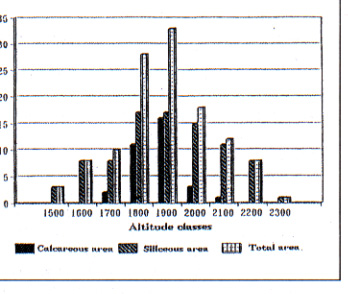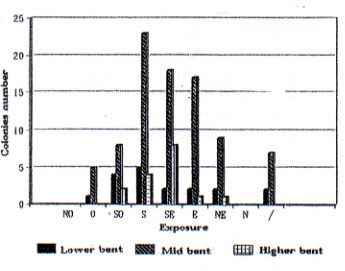Bassano B., Durio P., Gallo Orsi U., Macchi E
eds., 1992. Proceedings of the 1st Int. Symp. on
Alpine Marmot and genera Marmota. Torino.
Edition électronique, Ramousse R., International Marmot Network, Lyon 2002
THE ALPINE MARMOT (Marmota Marmota) ON "OROBIE" ALPS AND "BERGAMASCHE" PREALPS PRELIMINARY OBSERVATIONS FOR AN ANALYSIS OF THE POPULATION
Panseri M.*
Collaborator of the Natural Science Museum "Enrico Caffi", Piazza Cittadella - Bergamo - Italy
Abstract - On account of historical researches, it has been possible to analyse carefully the population of marmot living on Orobie Alps and Bergamasche Prealps. This analysis has identified the structure of the average colony, the density of population and its distribution in accordance with 4 parameters: altitude, exposure, geomorphological features and vegetation.
PREFACE AND HISTORICAL OUTLINES
Our research has been done on the "Orobie bergamasche", a range of mountains that is divided into two quite distinct litological zones: the "Alpi Orobie" of siliceum geological origin; and the "Prealpi bergamasche", characterised by the calcareous-dolomitic rocks. After their disappearance from the "Orobie" in the first decades of ouf century, marmots have been artificially brought there again, since the end of the 60's.
METHODOLOGY
We differentiated three model areas, where we took a census in the summers of '85 and '86: Zone A (29400 ha) in the siliceous area; Zone B (3200 ha) and Zone C (6400 ha) in the calcareous area. By these areas we collected the following data: 1) the topographical location on 1:25.000 I.G.M. map; 2) the number of marmots seen at the same time, specifying if they were adults or whelps boni in the year; 3) the altitude; 4) the exposure of the whole colonized surface; 5) the feature of the surroundings, divided into detrital, rocky and terrigenous; 6) the places, rocky or terrigenous, from which we caught the sight of marmots; 7) the entrances, evident or not; 8) the material of the boring; 9) the presence or the absence of pasture and its extension; 10) the presence or the absence of vegetation. Ten colonies were periodically observed during the whole period of their activity.
RESULTS AND DISCUSSION
The research was about the analisys of density and the distribution of the colonies. Marmots have got particular biological needs which should be satisfied by the habitat where they live (Couturier, 1964; Huber, 1978). They are respectively linked to: 1) the alimentary distribution; 2) the microclimatic condition, above all the insolation; 3) the defence possibility, which depends on the width of the visual field and on the chance of boring a barrow.
The colonies: the ten regularly observed colonies consisted of 1-4 family units, of 3-10 adults (yearlings and whelps born in the previous year, grown up animals) each, 4 whelps born in the year. Such data describe quite well the real situation, but they are not exhaustive and referable to each colony living on the "Orobie".
Density: in the siliceous area we counted 88 colonies, 33 in the calcareous one. They both had an "aspecific density" of 0,003 colonies/ha. Their distribution was not regular: they seemed to be "casually gathered". In the areas we did out research we counted 235 head of marmots: 46 whelms and 189 adults. Since we knew the true number of head in ten colonies, the average values could be multiplied by the number of the colonies. The result represented the quantity of marmots on the area: 290 whelms, 459 adults. The 38 % of population consisted of whelms born in the year; that is why we could think of a young and healthy population.
Distribution: it depends on: 1) the altitude - in fact in the siliceous area the 68 % of the colonies is between 1700-2100 metres, while in the calcareous area between 1800-1950. In the lower bent the lack of a wide visual field acts as a restricting factor; on the other hand in the higher bent the restricting factors are the alimentary and microclimatic features, above all the windiness; 2) the exposure - we considered the exposure of the whole colonized surface. Marmots mostly live on slopes looking south, south-east or east, but they prefer slopes facing south east or east when the altitude increases, because of the presence of sun since dawn; 3) the geomorphological features by the siliceous geomorphological areas, colonies are quite regularly divided between terrigenous areas (55 %), typical of a lack of activity, and detritical areas (44 %). Only 1 % of them is by a rocky area. By the calcareous zone the area which is colonized is the detritical one (73 %); while by terrigenous zones there is no colony because of the presence of cattle. Colony number in the carsicous areas coincided with the 27 %. They got the barrow system from the room they could find ong the stones; 4) the vegetation - it has a great influence on the distribution both as alimentary source and as a visual barrier. No colony but two have been found in this area.
Â
Â
LA MARMOTTA ALPINA (Marmota marmota marmota, L, 1758) SULLE ALPI OROBIE E SULLE PREALPI BERGAMASCHE. OSSERVAZIONI PRELIMINARI PER UN'ANALISI DELLA POPOLAZIONE
Panseri M.*
Collaborator of the Natural Science Museum "Enrico Caffi", Piazza Cittadella - Bergamo - Italy
Premessa e cenni storici
Il lavoro é stato svolto sui versante bergamasco delle Orobie, questa catena é divisa in due unità litologiche ben distinte: le alpi Orobie di natura geologica silicea e le "Prealpi Bergamasche" di natura calcareo-dolomitica.
La Marmotta, scomparsa nei primi decenni del secolo su tutto l'arco orobico, é stata reintrodotta artificialmente a partire dalla fine degli anni '60.
Metodologia
Sono state identificate tre aree campione, dov'é stato effettuato il censimento nell'estati '85-86: area A (29.400 ettari) situata nella zona silicea; area B (3.200 ettari) e area C (6.400 ettari) situate nella zona calcarea.
In queste aree sono stati raccolti i seguenti dati: 1) localizzazione topografica su tavolette I.G.M 1:25.000; 2) numero degli individui avvistati contemporaneamente specificando se adulti o cuccioli dell'anno; 3) altitudine; 4) esposizione dell'intera superficie coloniale; 5) caratteristiche dell'ambiente distinte in detritico, roccioso, terrigeno; 6) luoghi di avvistamento situati su massi o terrazzini terrosi; 7) entrate, evidenti o no; 8) materiali di scavo, presenti o no; 9) pascolo, assente o presente ed in quale entità ; 10) vegetazione, presente o no.
Dieci colonie sono state periodicamente osservate durante tutto il periodo di attività .
Risultati e discussione
L'indagine verte principalmente sull'analisi delle densità e della distribuzione delle colonie. La Marmotta ha esigenze ecologiche ben precise, che l'habitat colonizzato o potenzialmente colonizzabile deve essere in grado di soddisfare (Couturier, 1964 e Huber, 1978).
Queste sono: 1) la disponibilità alimentare; 2) le condizioni micro-climatiche, soprattutto l'insolazione; 3) le possibilità di difesa, dipendenti dall'ampiezza del campo visivo e dalla possibilità di scavarsi una tana.
a) La colonia
Le dieci colonie osservate regolarmente, presentano la seguente struttura, sono costituite: da 1 a 4 nuclei famigliari, da 3 a 10 adulti (yearlings e sub-adulti compresi), da 0 a 4 cuccioli dell'anno. Tali dati sono indicativi della situazione, non certo esaustivi e riferibili a tutte le colonie presenti suite Orobie.
b) DensitÃ
Nell'area silicea sono state censite 88 unità coloniali, in quella calcarea 33, in entrambi i casi si ottiene un valore di densità aspecifica pari a 0.003 colonie/ha. La distribuzione non é uniforme ma ricalca un modello di "dispersione raggruppata casuale". Nelle aree percorse é stato censito un minimo numero certo di capi pari a 235 unità : 46 cuccioli e 189 adulti. Dato che si possiede il numero reale di capi in 10 colonie, i valori medi possono essere moltiplicati per il numero delle colonie, possiamo cosi stimare la popolazione presente nella superficie censita, pari a 750 unità : 290 cuccioli e 459 adulti. Il 38 % della popolazione é costituita da cuccioli dell'anno, si può ipotizzare una piramide delle età con base molto ampia, struttura tipica di una popolazione giovane ed in ottimo stato di salute.
c) Distribuzione
Questa varia in funzione dei seguenti parametri. 1) Altitudine - Nell'area silicea il 68 % delle colonie é situato tra il 1700 ed 12100 m, in quella calcarea tra i 1800 ed i 1950 m. Nella fascia più bassa, la mancanza di un ampio campo visivo, funge da fattore limitante; nella fascia più alta le caratteristiche alimentari e microclimatiche, soprattutto la ventosità , sono i fattori limitanti. 2) Esposizione - viene considerata quella dell'intera superficie coloniale. Il maggior numero di colonie si trova in aree esposte a sud, sud-est, est; con l'aumentare della quota, oltre all'esposizione nord e nord-ovest, viene disertata anche quella ovest, la massima concentrazione é presente in quelle sud-est, che assicurano una buona insolazione sin dal primo mattino.
3) Manifestazioni geomorfologiche - nelle zone silicee le colonie sono quasi equamente distribuite tra ambiente terrigeno (55 %), tipico di manifestazioni geomorfologiche ormai inattive, e ambiente detritico (44 %), solo l'1 % si situa in ambiente roccioso. Nelle aree calcaree l'ambiente prevalentemente colonizzato é quello detritico (73 %), falde di versante ampie ed attive; mentre in ambiente terrigeno, vista la minima disponibilità e l'elevato carico di bestiame, non vi é alcuna colonia; le colonie censite in ambiente carsico corrispondono al 27 %: il sistema tana é ricavato nel reticolo di fessure dei "campi carreggiati". 4) Vegetazione - influisce sulla distribuzione sia come fonte alimentare sia per effetto di barriera visiva, espletata dalle essenze arboree ed arbustive. Nessuna colonia é stata censita in aree arborate, solo due in zone con densa copertura alto-arbustiva.
REFERENCES
COUTURIER M., 1964 - La Marmotte des Alpes. In Le Gibier des montagnes française. Arthaud Ed.: 137-165.
HUBER W., 1978 - La Marmotte des Alpes. O.N.C., Paris, 30 pp.
Tab. 1 - Statistical values or altitude distribution
|
Val. in m. |
AREA A |
AREa B+C |
|
v.m. |
1909 ~ 1900 |
1881 ~ 1875 |
|
190 ~ 200 |
81 ~ 75 |
|
C.V. |
9,95 % |
4,3 % |
|
v.m. ± |
1700-2100 |
1800-1950 |
Fig. 1: Distribution of frequencies in 100 metres altitude classes.

ritorno/back
Fig. 2: Distribution of colonies in exposure classes according to the three altitude bents.

ritorno/back
Tornare index / back contents
Â

